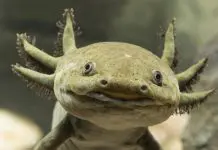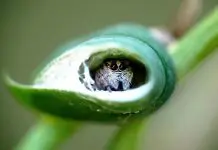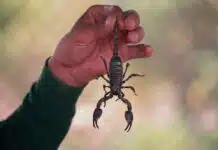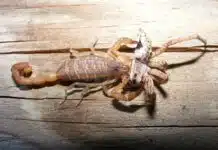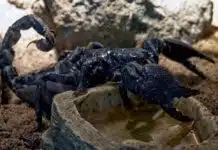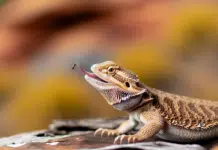Snakes hiss. You probably know this if you have a pet snake at home or if you have come upon a hissing snake outdoors. But have you ever stopped to ask yourself, “how do snakes hiss? Or, why do snakes hiss?”
Snakes can hiss when they feel threatened. Snakes can also hiss when they want to intimidate a predator. Snake hissing is also a sign that a snake is stressed by your presence and that it wants you to leave. This trait is common among all snakes, although hisses made by smaller snakes tend to be quieter and barely audible.
In this article, we will discuss how and why snakes hiss, and explore common sounds that snakes make, besides the snake hissing sound. In addition, we will tell you what to do when you hear snakes hissing or making other snake sounds.
Why Do Snakes Hiss?
A snake hiss is a defence mechanism. Cobras, vipers and other venomous snakes, hiss to warn off an approaching predator. As bites from venomous snakes are usually fatal, it’s always best to heed the warning of venomous hissing snakes and back off.
Non-venomous snakes also evolved the ability to hiss for defensive purposes. Biologists maintain that in order to deter predators, non-venomous snakes mimic the behavior of a hissing cobra or other venomous snake such as vipers.
To recap, if you hear a snake hissing, it could be for these reasons:
- It senses a predator approaching it
- It hears you (or another animal) approaching and mistakes you for a predator
- The snake wants to be left alone. This is common for a domesticated snake after overhandling
Do snakes hiss to communicate with each other?
Hissing is not a form of communication between snakes. Numerous studies have found that while snakes can respond to sound and vibration, their hearing of airborne sounds is limited to frequencies ranging between 150 to 600Hz.
The studies found that snakes cannot respond to sounds above 3000Hz. As hissing frequency ranges between 3000hz to 13,000hz, the scientists concluded that snakes cannot hear hissing sounds made by themselves or other snakes.
Understanding how snakes Hiss
You and your snake have one thing in common: you both have an organ in the throat called the glottis. In humans, the glottis vibrates allowing you to produce voice or pronounce words. In snakes, the glottis serves two purposes: breathing and hissing
How do snakes hiss? The role of the glottis
A snake’s glottis is located under the tongue and is part of the trachea. Normally, the glottis of a snake stays closed. In this closed state, the glottis forms a vertical slit. When a snake breathes, the slit opens to reveal a small rounded hole.
Figure 1: A snake’s glottis. Image from wikivet
As earlier mentioned, a snake needs the glottis to:
Breathe
Snakes swallow their prey whole. For this to happen, the jaws of a snake allow the mouth to stretch wider than the snake’s body. In this stretched state, snakes cannot breathe through their nostrils but instead rely on the glottis, which extends outside the mouth during feeding.
Hiss
You may think of hissing as a form of noisier breathing. During normal inhalation, air passes through the snake’s glottis without making a sound. However, when agitated or threatened, snakes force air out through the glottis, causing the cartilage in the glottis to vibrate. These vibrations are what produce the hissing sound.
Some snakes produce hissing sounds during inhalation while others hiss during exhalation. A study conducted by the Biological Journal of the Linnean Society found that only 25% of grass snakes hiss during inhalation, as compared to 100% of vipers and 84% of viperine snakes. Exhalation hissing also tends to be louder than inhalation hissing.
Do snakes have vocal cords?
Snakes do not have vocal cords. A paper from the cyclopedia of anatomy and physiology observes that snakes, including boas and pythons, lack vocal cords, and this reduces their voices to hissing.
Do All Snakes Hiss?
All snakes have a glottis, the organ responsible for the snake hiss. Therefore, from a physiological point of view, all snakes possess the ability to hiss. However, some snakes are likely to hiss more than others. As well, some snakes can emit a louder hissing snake sound than others.
For instance, the hissing viper snake (also known as the hognose or spread-head viper), tends to be docile and rarely hisses especially when domesticated. But due to their small size, hissing viper snakes are vulnerable to prey particularly in the wild. To deter predators, the hognose snake hisses and puffs its neck to imitate deadly snake species such as the python.
Figure 2: Different patterns of the hissing viper (hognose)snake. Images from Wikipedia
Snake hissing is not just a function of species, or physiology, but also of habitat. Captive snakes tend to hiss less as they live in an environment that is not threatening. Your snake might start out hostile at first but as you continue handling him, he becomes used to you and comes to perceive you as unthreatening.
Why Does My Snake Hiss at Me?
We have already mentioned that pet snakes rarely hiss. But even the most docile of snakes will hiss from time to time, for reasons such as:
#1 When you startle him
You could startle your snake by suddenly moving or surprise him by unexpectedly handling him. As your snake probably mistakes you for a predator, he may hiss in response, although the hissing should stop when your snake realizes that he is not being attacked by a predator.
It’s always important to keep your pet snake calm and you can do this by:
- Approach slowly and from a place where he can see you
- Handle your snake by holding his body. Do not handle a snake by holding its head or tail.
#2 He is not domesticated
If your pet snake has been hissing at you, it is likely that he needs to be socialized a little more so that he can relax whenever he sees you. Especially when they are young, snakes tend to be aggressive and will even strike at you when they feel threatened.
Regular handling teaches snakes that people are not a threat. To socialize your snake, handle him regularly so that he gets used to having you around. As well, get your snakes from a breeder who only breeds species that are easy to domesticate.
Note that wild snakes are difficult to domesticate and attempting to do so is dangerous.
#3 Over-handling
You want to spend as much quality time with your pet snake but sometimes, he hisses at you and doesn’t want to see you. So, what does it mean when a snake hisses during handling?
Spending time with your pet is a sign of affection. What you may not realize is that in their natural habitat, snakes live a solitary life. Although your snake may be accustomed to your petting and handling, his natural tendency will kick in from time to time, during which he will want to be alone. If you handle your snake when he wants to be left alone, he may get agitated and hiss.
To avoid over-handling, space out handling time and down-time to ensure you give your snake enough of both.
#4 Your snake is in pre-shed
Skin shedding is common in reptiles and mammals. In most animals and humans, skin shedding is ongoing, happens in bits and is barely noticeable. Among snakes however, skin shedding (also known as molting or sloughing) happens up to four times in a year. If your pet snake is young, you may notice shedding every two weeks.
There are two main reasons why your snake sheds his skin:
- Your snake has outgrown his skin. A snake’s skin doesn’t grow as the snake grows, hence your snake will periodically outgrow his skin. When this happens, he will shed to allow new skin to grow.
- To get rid of parasites
Skin shedding can be a stressful time for a snake. This is because the process is energy intensive. More so, in the pre-shed period, your snake’s old skin will tear off easily and as the new skin that is forming underneath is not yet mature, handling may be uncomfortable. Your snake will retreat and hide, may hiss at you or get aggressive when you approach or try to handle him.
Below are signs that your snake is about to shed. Note that before the new skin matures, your snake will be prone to scarring, so handling should be avoided altogether. To protect your snake, give him his space when you notice these signs:
- When your snake is in the pre-shed period, his skin will turn dull. His eyes will also turn milky as the spectacle, which is the outer layer of the eye, also prepares for shedding.
- Reclusive behavior or trying to hide
#5 Your snake just ate
Snakes eat large meals. Their teeth are not adapted for chewing and for this reason, they swallow their prey whole. After feeding, digestion can take days or weeks to complete. During this period, snakes prefer to be secluded and relaxed. If you disturb a snake during digestion, he will become agitated and will hiss to warn you off.
Besides hissing, disturbing your snake while he is digesting could trigger regurgitation. Dr. Douglas R. Mader, a veterinarian, warns that when snakes are startled after feeding, they regurgitate their food to facilitate the fight or flight response. After feeding your snake, give him a few days to digest in silence as handling him too soon after feeding will upset him.
Whenever your snake hisses, start by looking at the reasons given above. If none of them seem to be the reason behind your snake’s hisses, it’s always best to leave him alone and attend to him later.
What other sound does a snake make?
If you ask most people, “what sound does a snake make?” most will tell you “hissing”. This is correct but besides hissing, snakes make other noises, all of which have different meanings. Let’s look at these snake noises in greater detail.
Rattling
Rattlesnakes have a rattle at the tip of their tails. When they vibrate the rattle, its segmented parts collide with each other to produce a loud rattling sound that warns off predators. Rattle snakes make this rattling noise whenever they feel threatened. Although rattling is the default defense snake sound that rattlesnakes make, do not be surprised to hear a rattlesnake hiss when threatened.
Some snakes in the viper family as well as non-venomous colubrids like the rat snake, also make rattle-like sounds even though they don’t have rattles. These snakes make rattling sounds by hitting rocks or tall grass with their tails.
Growling
The king cobra is the longest venomous snake in the world. King cobras feeds on other snakes, including venomous snakes like pit vipers and cobras. The king cobra is also the sole member of its own genus, despite its name “cobra”. Although king cobras are reputed to shy away from humans, they can get very aggressive when confronted and produce a loud hissing sound.
A king cobra hiss resonates below 2500 hz and is dominant at 600hz. At this low frequency, cobra hissing is “closer to that of a human voice” and sounds like growling. The lower frequency of a king cobra’s hiss can be attributed to the tracheal diverticula, which resonate at a lower frequency.
Ironically, the mangrove ratsnake, a common prey of the king cobra, also growls.
Cloacal Popping
The western hook-nosed snake and the sonoran coral snake have many similarities. They are both small snakes, they burrow, and they are both native to northwestern Mexico and the southwestern United States. They also share a common defense mechanism, known as cloacal popping.
The cloaca is a tract through which snakes pass waste and lay their eggs. When the Western Hook-nosed Snake and the Sonoran coral snake are threatened, they force air through the cloaca, making a loud popping sound that has been likened to “farting”. Unsurprisingly, the air has an unpleasant smell.
Cloacal popping and the snake sounds produced during this defensive behavior, have been observed in several studies. In a laboratory study of the western hook-nosed and sonoran coral snakes conducted by Bruce Young at Lafayette College, the morphologist concluded that cloacal popping happens when snakes feel threatened. The morphologist reported that in some cases, the popping was so energetic that it lifted the snakes off the ground.
Scale Rubbing (stridulation)
The saw-scaled viper, a small, irritable, aggressive and venomous snake, produces a defensive snake noise that is different from most other snakes. When the saw-scaled viper feels threatened or alarmed, it arranges itself into S-shaped coils and as it does so, its scales rub against each other producing a sound that is like the hiss of a snake. This is known as stridulation.
When a saw-scaled viper issues this warning sound, it’s always best to avoid it. This is because saw-scaled vipers are quick to strike, and their bite often results in fatalities. Vipers, which are native to the arid parts of Africa, Asia and Arabia, are reported to cause more fatalities than all other snake species in those regions.
Other snake noises and what they mean
Snakes noises are not all defensive in nature. Certain snake sounds can be caused by:
Movement
When your snake is moving around in his terrarium, you will hear noises as his scales rub against objects, substrate and plants. This is normal, unless the movement seems agitated.
Flatulence
Do snakes make sounds when passing gas? Absolutely yes. Flatulence is different from the defensive cloacal popping. Snakes make a loud gurgling sound when passing wind. Do not be alarmed if you hear this sound coming from your pet snake,.
Illness
Snakes get sick. They can suffer from bacterial, fungal or viral infections, any of which can cause wheezing, nasal discharge and breathing through the mouth. Your snake’s breathing may be wheezy, rattly or gurgly if it has any infection that causes discharge.
Note that in addition to noisy breathing, a snake with a respiratory infection such as pneumonia will prop up his head and neck to prevent fluid buildup in its airways. Get your snake medical attention immediately you notice these symptoms.
Conclusion
Hopefully, this article has answered the following questions for you:
- What is hissing?
- The role of the glottis in snake hissing.
- What does it mean when a snake hisses? How should you respond?
- Do snakes make noise? What sounds do snakes make? Different sounds made by different species of snakes and what those sounds mean.
Hissing is the sound a snake makes in response to threats. It is a snake’s way of telling you that you need to back off. The other snake sounds discussed above are also produced by snakes when they feel threatened.
Your response in such cases should be to keep your distance, especially when in the wild. If you notice hissing in your domesticated snake, use a process of elimination to determine the reason behind the hissing. Then take the appropriate action. For instance, if the hissing happens after feeding, give your snake time to digest. If you suspect the hissing is related to poor socialization, see a breeder for advice on how to domesticate your pet snake.

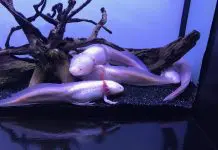
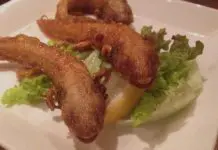
![Sick Axolotl, Fungus, Stress Symptoms [Axolotl Illness Guide 2025] Axolotl fungus](https://exopetguides.com/wp-content/uploads/2018/06/axolotl-218x150.jpg.webp)
